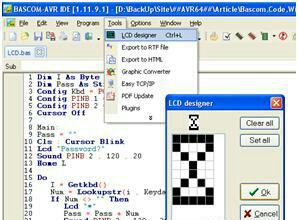(Bascom AVR)متن فارسی در LCD کاراکتری برنامه نویسی در محیط برنامه بسکام (مهندسی برق_ الکترونیک)
پژوهشگر و نویسنده: دکتر ( افشین رشید )
نکته : Lcd های کاراکتری دارای یک حافظه دائم می باشد که درون ان فقط کد، کاراکتر های اسکی وجود دارد (کد کارکترهای فارسی در ان وجود ندارد) .
در lcd حافظه موقتی وجود دارد که در ان می توان تا 8 کارا کتر دلخواه را قرار داد .برای ساخت کاراکتر دلخواه مراحل زیر را دنبال کنید: از منوی tools گزینه designer lcd را انتخاب کنید، پنجره جدیدی باز می شود که شما می توانید در ان کاراکتر دلخواه خود را ایجاد کنید. بعد از ایجاد کاراکتر دلخواه روی ok کلیک کنید ،پنجره بسته می شود و یک خط به برنامه شما اضافه می شود.
مانند زیر:
Deflcdchar ?,1 ,4 ,4 ,4 ,4,31,20,4
به جای علامت سوال باید یکی از اعداد 0تا 7 می باشد گذاشته شود . بعد از ساخت کاراکتر جدید بادستور زیر می توانید ان را روی lcd نشان دهید:
(Lcd chr ) ?
به جای علامت سوال باید شماره کاراکتر که یکی از اعداد 0تا 7 می باشد گذاشته شود . مانند:
$regfile="m16def.dat”
$crystal=8000000
Config Lcd = 16*2
Config lcdpin=pin ,
db4=pinc.0,db5=pinc.1,db6=pinc.2,db7=pinc.3,rs=pinc.4,e=pinc.5
Deflcdchar 0,1 ,4 ,4 ,4 ,4,31,20,4
Locate
Lcd chr)0)
End
یک گزینه در منوی tools برای طراحی و ویرایش فونت فارسی می باشد. برای نصب این برنامه از منوی Tools روی PlugIn Manager کلیک کرده و چک باکس Fonteditor.bpl را تیک بزنید. در صورتی که چنین چیزی وجود نداشت بایستی آن را از یکی نسخه های بسکام کپی کرده و در پوشه Plugins واقع در محل نصب برنامه ذخیره نمایید. پس از تیک زدن این گزینه و زدن دکمه OK یک بار بسکام را ببندید و مجدداً باز کنید، سپس از منوی Tools روی Plugins و سپس روی Font Editor کلیک نمایید.
پژوهشگر و نویسنده: دکتر ( افشین رشید )




